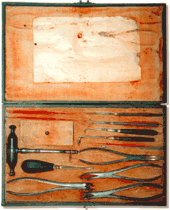


The Instruments for Dental Extraction
The tooth key appears described for the first time in the work of Alexander Monro "Medical Essais and observations" (1742). It seems however, that it's use dates from 1730. The first French illustration of a tooth key appears in the works of Bourdet (1757). As its name indicates, in the first times of it's manufacture this instrument had the appearance of a domestic key with a ring-like proximal end. Progressively the handle became key-shaped. In the distal end there was a hook-shaped metallic structure. This part molded to the tooth and through a rotation applied on the instrument made it slide. The model which became most popular was the one of Garengeot (C.1770). The tooth key had wide acceptance. The screws aimed the extraction of the roots of incisive and canine teeth. The first reference to this instrument seems to be of 1803 from Serre and Laforgue. It was part of compound instruments. The dental forceps is most probably the mot remote dental instrument. It might well have been a successor of our human appendixes: the fingers. Mentioned in texts from the Greco-Roman Antiquity and from the Medieval Period it is part of the heritage of museums that own instruments from this period. We remind the instruments of Pompeii and Herculano (97dc) shown in the museum of Naples, Italy. Used as dental extractor it had different shapes and names, these resulting from its shape resembling the beak of a bird or of the jaw of a dog. Albucasis (10th - 11th century), Walter Ryff (1545), Jacques Guimeau (1598), John Woodall (1617), Fauchard (1728), Leber (1770), Perret (1772) among others, attached to their scripts extensive iconography concerning this instrument. Syrus Fay (1778-1839), while studying the process of dental extraction, idealized the shapes of forceps that most favored the extraction of the different types of teeth, considering even the existing pathological state. This feature of improved adaptability of the distal end of the dental forceps to the tooth was allied to a similar demand of articulation between the hand of the user and the instrument. Josiah Foster Flagg from Boston (1763-1816) owned a set formed by eleven dental forceps, each of them adjusted to the anatomy of each tooth. The idealization of the forceps whose shape is most similar to the modern one was a responsibility of Sir John Tomes ("On the construction of and application of forceps for extracting teeth" 1841). The production of the dental forceps of Sir John Tomes was of the responsibility of the manufacturer Everhard (1801-1882): a set of forceps with complementary functions.
The dental cautery was used as physical method of haemostasis after the dental extraction, in the gum cauterization and as a palliative agent or for counter-irritation in case of pain. The cautery in general pleased the Arabs. Among these, the one who better described and illustrated the cautery was Albucasis. It was widely used during the whole Middle Age. Its form and the nature of its materials varied with time. A handle made out of isolating material allowed holding the instrument during and after the heating of the metal. In 1851, George Derby Waite (1804-1880) presented an electrical cautery, having many versions of it being produced.
